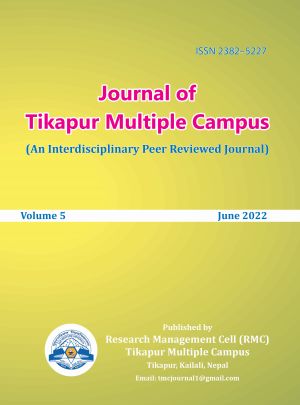भाषापाठ्यक्रममा ब्लुम्स टेक्सोनोमीको उपयोग {Use of Blooms Taxonomy in Language Curriculum}
DOI:
https://doi.org/10.3126/jotmc.v5i1.46654Keywords:
स्थानीय पाठ्यक्रम, सिकाइ उपलब्धि, संंज्ञानात्मक, मनोक्रियात्मक, वर्गीकरण, भावनात्मकAbstract
प्रस्तुत भाषा पाठ्यक्रममा ब्लुम्स टेक्सोनोमीको उपयोग शीर्षकको लेखबेन्जामिन ब्लुम र उनका सहयोगीहरूले गरेकोशैक्षिक उद्देश्यको वर्गीकरण र सोअनुरूप वर्तमान कक्षा दसका कक्षागत सिकाइ उपलब्धिको विश्लेषणमा केन्द्रित छ ।यस लेखमा शैक्षिक उद्देश्यको वर्गीकरणका बारेमा अध्ययन गरिएको छ ।शैक्षिक उद्देश्यको वर्गीकरणका मान्यतालाई नेपालीभाषा शिक्षणसँग जोडेर हेरिएको छ । यसमा दस्तावेज अध्ययन विधिकोअनुसरण गरेर तथ्यहरू खोजी गरिएको छ र उक्त तथ्यहरूको तार्किक र सङ्ख्यात्मक विश्लेषण गरिएको छ । यस लेखमा ब्लुम्स टेक्सोनोमीमा रहेका शैक्षिक उद्देश्यका तीनक्षेत्र संज्ञानात्मक, भावनात्मक र मनोक्रियात्मक र अन्य उपक्षेत्र वा तह रहेका कुराको उदाहरणसहित चर्चा गरिएको छ ।यसै गरी नेपालमा बेन्जामिन ब्लुमका शैक्षिक उद्देश्यको वर्गीकरण बारेको सैद्धान्तिक तथा व्यावहारिक जानकारीको अभावरहेकाले पाठ्यक्रम विकासका क्रममाशैक्षिक उद्देश्य निर्माणमा धेरै विसङ्गतिहरू रहेका छन् । उद्देश्यको वर्गीकरणलाई अनुसरण नगरी पाठ्यक्रम निर्माण गर्दा कुनै क्षेत्र र तहका उद्देश्य अत्यधिक रहने र कुनै छुट्ने सम्भावना रहन्छ । नेपालको वर्तमान सन्दर्भमा स्थानीय पाठ्यक्रमका उद्देश्यहरू पनि निर्धारण गर्नुपर्ने भएकाले यसको महŒव झन बढेर आएकोछ । यसमा विद्यार्थीहरूको सर्वाङ्गीण विकासमा मद्दत पु¥याउन,व्यक्ति, समाज रराष्ट्रलाई शिक्षामार्फत सही दिशा प्रदान गर्नब्लुमका उद्देश्यको वर्गीकरणका आधारमा शिक्षाका लक्ष्य र उद्देश्यहरू तय गर्नु अपरिहार्य रहेको तथ्य प्रस्तुत छ । यसमा नेपाली भाषा सिकाइका सन्दर्भमा कक्षा दसको नेपाली भाषा पाठ्यक्रमका कक्षागत सिकाइ उपलब्धि तथा भाषिक सिपगत उद्देश्यहरूको विश्लेषण पनि गरिएको छ । यी कक्षागत सिकाइ उपलब्धि वा उद्देश्यहरूमा ब्लुम्स टेक्सोनोमीको प्रतिबिम्बन पर्याप्त मात्रामा देखिएको छ ।यस आधारमाभाषा पाठ्यक्रममा ब्लुम्स टेक्सोनोमीको उपयोगको अवस्था उपयुक्त रहेको रयसको महत्व पनि बढ्दै गएको निष्कर्ष प्रस्तुत गरिएको छ ।
{The use of Blooms Texonomy in the present language curriculum focuses on the classification of educational objectives by Benjamin Bloom and his colleagues and the analysis of current class ten learning achievement accordingly. It seeks facts by following the method of document study and provides logical and numerical analysis of the facts. This article discusses the three areas of educational objectives in Blooms Texonomy, cognitive, emotional and psychological, and other sub-areas or levels. When creating a curriculum without following the classification of objectives, there is a possibility that the objectives of some area and level will be excessive and some will be missed. In the current context of Nepal, the objectives of the local curriculum also need to be determined, so its importance has increased. It presents the fact that it is essential to set the goals and objectives of education based on the classification of Bloom's objectives to help in the all-round development of the students, to provide the right direction to the individual, society and nation through education. It also analyzes the classroom learning achievement and linguistic skills objectives of the Nepali language curriculum for class ten in terms of Nepali language learning. These classroom learning achievements or objectives reflect the Blooms Texonomy substantially.}
Downloads
Downloads
Published
How to Cite
Issue
Section
License

This work is licensed under a Creative Commons Attribution-NonCommercial 4.0 International License.
This license enables reusers to distribute, remix, adapt, and build upon the material in any medium or format, so long as attribution is given to the creator. The license allows for commercial use.




